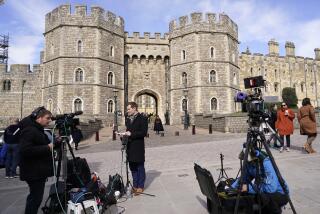Pair of palatial fixer-uppers pose challenge in Britain
They reign and rule over Britain, but now there’s a plague on both their houses.
Queen Elizabeth II and members of the British Parliament live and work in this country’s two most iconic buildings: Buckingham Palace for her, the Palace of Westminster for them. But moisture, mice and moth-eaten heating and electrical systems, among other ills, are turning both structures into something of a nightmare for their illustrious inhabitants.
Conditions inside the 19th century buildings have become so dire that they threaten to achieve what the Nazi blitz of London could not: force Her Majesty, the noble peers in the House of Lords and the uppity members of the House of Commons to abandon their digs, at least while refurbishment is undertaken.
Surveyors and engineers warn of an urgent need for asbestos removal, better plumbing, pest control, upgraded wiring, improved fire safety and repairs to the crumbling masonry, a large chunk of which came perilously close to nailing Princess Anne’s car after detaching from a Buckingham Palace parapet in 2007.
But spending billions in taxpayer money on nicer accommodation for politicians and the royal family is a tough sell at a time when the government is promising the deepest cuts in welfare and other social spending in at least a generation. Plenty of Brits believe that their elected representatives, as well as their unelected dynasts, have dipped their hands liberally enough into the public purse.
To Dickie Arbiter, that’s a shortsighted view.
“All these are government buildings,” said Arbiter, who spent a dozen years toiling within the elegant confines of Buckingham Palace as Elizabeth’s press secretary before retiring. “Our children and grandchildren and their children won’t thank us if we allow these buildings to fall into a state of disrepair.”
He scoffs at suggestions that his former boss, one of the world’s richest women, ought to fund her own home improvements. The queen does not actually own Buckingham Palace; it’s held “in trust” for use by the reigning monarch.
“There are those cynics who say, ‘Well, the queen lives there, she should pay for it,’ which is a bit like saying, ‘Obama lives at the White House, let him take care of it,’” Arbiter said.
Regardless of who foots the bill (and it won’t be the footman), the price tag would be enormous.
Buckingham Palace is basically a 240-bedroom, 78-bathroom fixer-upper (great location!) that would cost an estimated $230 million to bring up to modern standards. Some redecorating is definitely in order: For all its opulent trappings, the last time the interiors were spruced up was around the time of the queen’s coronation. That was 62 years ago.
The boiler hasn’t been overhauled in about as long. Royal minions have had to set out buckets to catch water dripping from the roof in the gallery where Elizabeth’s priceless art collection is kept.
Across St. James’ Park, a makeover for the Gothic Revival Palace of Westminster — famed for the clock tower mistakenly called Big Ben, which is actually the name of the giant bell inside the belfry — would cost significantly more. According to an independent appraisal released in June, the project could run from $5.4 billion to $8.8 billion.
Mark Tami, a member of Parliament from the Liverpool area, said a “major intervention” is clearly necessary.
“You’re talking about a building which is in the center of London, which is exposed to the elements and pollution,” he said. “There comes a point where just the odd patching here and there won’t suffice.”
The roof leaks, the pipes are corroding and much of the communication cabling is inadequate for the demands of the digital age. It took “quite a time” to install broadband and Wi-Fi, Tami said; connection speeds remain erratic.
Tami sits on a “restoration and renewal” parliamentary committee that is expected to decide early next year whether to embrace one of the renovation plans outlined in the June report.
The least expensive option would require Parliament to move out of the Palace of Westminster for six years. That’s called a “full decant” — an apt description for a place where lawmakers hobnob in their own private bar overlooking the Thames and where some have been known to cast votes on legislation in a “tired and emotional” state (a popular euphemism for “falling-down drunk”).
The most expensive option would allow the 650 members of the House of Commons and assorted scarlet-robed lords and ladies mostly to stay put, with partial closures of the building on a rolling basis over 32 years.
But despite its steep $8.8-billion cost, the plan would only cover retrofitting the palace to minimum standards, including better access for the disabled and improved fire prevention. Lawmakers would also have to endure the racket and disruption that any homeowner who has ever done a renovation is all too familiar with.
Convincing the public of the merits of any of the choices will be a challenge. Although many Britons relish the idea of politicians being driven out of their offices, they would be less keen to know it was part of an overall scheme to provide them with more lavish public housing.
“If you want to have an efficient government, if you want our representatives do a proper job, they need to have a proper workplace,” said Steven Fielding, a political scientist at the University of Nottingham.
But “how it has been framed is of MPs just looking after themselves…. The way it’ll probably end up is they’ll spend the money, it’ll cause a stink and it’ll be filed in the back of people’s memories as, ‘This is another reason why we don’t like them.’”
Other suggestions have been floated, including taking Parliament on the road with stops around the country, or ditching the Palace of Westminster altogether for a more modern, more modest facility, to match Britain’s decline from the imperial colossus it was when the palace went up in Victorian times. The green, red and gold interior is littered with reminders of empire, in statues and paintings of events such as the Battle of Waterloo.
Those alternatives are about as likely as the queen abdicating. For all the money that refurbishing the Palace of Westminster and Buckingham Palace would require, the historical and symbolic value of the two buildings — where momentous decisions affecting both Britain and the world have been made — is incalculable for this tradition-loving nation.
Plus, they bring in tourists, who pay $28 to visit the Houses of Parliament and $32 to gawk at Buckingham Palace’s staterooms.
“If they were to propose in America to move the Senate and House out and build them a new building, there would probably be a massive outcry about that,” Tami said.
“Buckingham Palace symbolizes the institution of monarchy. It’s where everyone expects to be entertained by the sovereign,” said Arbiter, whose recent memoir, “On Duty With the Queen,” chronicles his years in service to the crown.
The royal family probably would be less inconvenienced than lawmakers by a move. Elizabeth, who is in good health at 89, already spends weekends and summers at Windsor Castle outside London and Balmoral Castle in Scotland, respectively. She could live comfortably in either place, or at her privately owned country retreat in Sandringham, in eastern England.
Buckingham Palace is where she mostly conducts state business on weekdays — “a bit like living above a shop when you’re on duty in London,” Arbiter said.
The queen has never openly complained about the condition of Buckingham Palace. But no doubt she’d like to see her principal pad since childhood, with its 775 rooms, kept in better shape.
“She certainly wouldn’t utter anything like that in public,” Arbiter said. “It’s really for the officials in that department to browbeat the powers that be to dish out the money, to say this building is going to fall to pieces unless something is done about it.”
More to Read
Sign up for Essential California
The most important California stories and recommendations in your inbox every morning.
You may occasionally receive promotional content from the Los Angeles Times.











